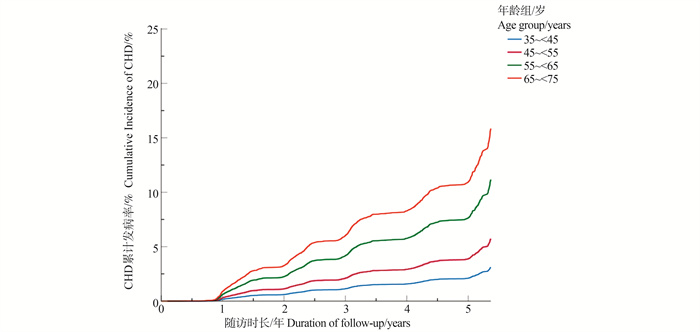Analysis of the risk factors of coronary heart disease in population at high cardiovascular risk in Inner Mongolia
-
摘要:
目的 探讨内蒙古地区心血管病高危人群冠状动脉粥样硬化性心脏病(coronary heart disease,CHD)发病的相关危险因素,为制定适合内蒙古地区CHD的防治策略提供科学依据。 方法 采用前瞻性队列研究方法,利用多阶段分层整群抽样方法。于2015年12月在内蒙古地区6个盟市开展调查,每年随访1次,直至2021年12月。基线调查包括一般情况、疾病史及治疗史、体格检查和实验室检测,随访调查包括心血管健康状况及临床终点事件收集。采用Cox回归模型分析影响CHD的发病因素。 结果 最终纳入37 726名研究对象,多因素Cox回归模型分析表明:增龄(HR>1.00, P < 0.001)、吸烟(HR=1.20, P < 0.001)、饮酒(HR=1.41, P < 0.001)、超重或肥胖(HR=1.19, P < 0.001)、高血压(HR=1.41, P < 0.001)、糖尿病(HR=1.22, P < 0.001)、血脂异常(HR=2.20, P < 0.001)为CHD发病的危险因素;高教育水平(HR < 1.00, P < 0.001)、非重体力劳动类型(HR < 1.00, P < 0.001)为CHD发病的保护因素。 结论 在内蒙古地区,增龄、吸烟、饮酒、血脂异常、高血压、糖尿病、超重或肥胖为CHD发病的危险因素,高教育水平、非重体力劳动为CHD发病的保护因素。 -
关键词:
- 冠状动脉粥样硬化性心脏病 /
- 影响因素 /
- 高危人群 /
- 队列研究
Abstract:Objective To explore the related risk factors of coronary heart disease (CHD) in the population at high risk of cardiovascular disease in Inner Mongolia, and to provide scientific basis for the development of prevention and treatment strategies for CHD in Inner Mongolia. Methods This study was a prospective cohort study, the study population was selected by multi-stage stratified cluster sampling method. A survey was conducted in six cities in Inner Mongolia region from December 2015, and the follow-up survey was conducted once a year until December 2021. The baseline survey included general information, disease and treatment history, physical examination and laboratory tests. The follow-up survey included cardiovascular health status and clinical endpoint events. Cox regression model was used to analyze the risk factors of CHD. Results A total of 37 726 subjects were finally included in this study, multivariate Cox regression analysis showed that: increasing age (HR>1.00, P < 0.001), smoking (HR=1.20, P < 0.001), drinking (HR=1.41, P < 0.001), overweight or obesity (HR=1.19, P < 0.001), hypertension (HR=1.41, P < 0.001), diabetes (HR=1.22, P < 0.001) were dyslipidemia (HR=2.20, P < 0.001) were risk factors for CHD. In contrast, high education level (HR < 1.00, P < 0.001) and non-heavy physical labor type (HR < 1.00, P < 0.001) were protective factors for CHD. Conclusions In Inner Mongolia, increasing age, smoking, drinking, dyslipidemia, hypertension, diabetes, overweight or obesity are risk factors for CHD, high education level and non-heavy physical labor type are protective factors for CHD. -
Key words:
- Coronary heart disease /
- Influencing factors /
- High-risk population /
- Cohort study
-
表 1 研究对象的一般特征
Table 1. Baseline characteristics of the participants
变量Variable 男性 ①
Male ①女性 ①
Female ①合计 ①
Total ①χ2值value P值value 年龄组/岁Age group/years 89.85 <0.001 35~<45 1 952(11.9) 1 951(9.2) 3 903(10.3) 45~<55 4 815(29.3) 6 443(30.2) 11 258(29.8) 55~<65 5 996(36.5) 8 352(39.2) 14 348(38.1) ≥65 3 652(22.3) 4 565(21.4) 8 217(21.8) 民族Ethnicity 2.56 0.278 汉族Han 14 756(89.9) 19 255(90.3) 34 011(90.2) 蒙古族Mongol 1 463(8.9) 1 826(8.6) 3 289(8.7) 其他民族Others 196(1.2) 230(1.1) 426(1.1) 劳动类型Labor type 794.95 <0.001 重体力劳动Heavy physical 7 800(47.5) 9 685(45.5) 17 485(46.3) 失业、家务或退休Unemployment, housework or retirement 4 115(25.1) 7 828(36.7) 11 943(31.7) 其他非重体力劳动Other non-heavy physical 4 500(27.4) 3 798(17.8) 8 298(22.0) 血脂异常Dyslipidemia 2 079(12.7) 4 539(21.3) 6 618(17.5) 477.83 <0.001 高血压Hypertension 13 764(83.9) 17 572(82.5) 31 336(83.1) 12.83 <0.001 糖尿病Diabetes 4 279(26.1) 4 947(23.2) 9 226(24.5) 40.89 <0.001 吸烟Smoking 8 102(49.4) 1 461(6.9) 9 563(25.3) 8 851.66 <0.001 饮酒Drinking 4 277(26.1) 347(1.6) 4 624(12.3) 5 144.70 <0.001 食用畜肉Eating meat 125.13 <0.001 从不或几乎不Never or almost never 672(4.1) 1 263(5.9) 1 935(5.1) 偶尔或每周<4次Occasionally or<4 times per week 8 276(50.4) 11 366(53.3) 19 642(52.1) 每天或几乎每天Every day or almost every day 7 467(45.5) 8 682(40.8) 16 149(42.8) 食用乳制品Eating dairy 10.15 0.006 从不或几乎不Never or almost never 5 967(36.3) 7 928(37.2) 13 895(36.8) 偶尔或每周<4次Occasionally or<4 times per week 7 200(43.9) 9 003(42.2) 16 203(43.0) 每天或几乎每天Every day or almost every day 3 248(19.8) 4 380(20.6) 7 628(20.2) 教育水平Educational level 1 546.24 <0.001 小学及以下Primary school and below 4 591(28.0) 9 998(46.9) 14 598(38.7) 中学及中专Secondary school 9 462(57.6) 9 717(45.6) 19 179(50.8) 大学及以上University and above 2 362(14.4) 1 596(7.5) 3 958(10.5) 家庭年收入/万元Annual household income/ten thousand yuan 250.49 <0.001 <1 3 211(19.6) 5 248(24.6) 8 459(22.4) 1~5 8 383(51.1) 11 143(52.3) 19 526(51.8) >5 4 821(29.3) 4 920(23.1) 9 741(25.8) 体育锻炼Physical exercise 3.32 0.190 从不或几乎不参加Never or almost never 9 680(58.9) 12 442(58.4) 22 122(58.7) 偶尔或每周<5次Occasionally or<5 times per week 2 146(13.1) 2 921(13.7) 5 067(13.4) 每天或几乎每天都锻炼Every day or almost every day 4 589(28.0) 5 948(27.9) 10 537(27.9) BMI 41.44 <0.001 低或正常体重Low or normal 3 919(23.9) 5 709(26.8) 9 628(25.5) 超重或肥胖Overweight or obesity 12 496(76.1) 15 602(73.6) 28 098(74.5) 注:①以人数(占比/%)表示。
Note: ① Number of people(proportion/%).表 2 CHD发病影响因素的Cox回归模型分析
Table 2. Cox regression analysis of the influencing factors of CHD
变量Variable 总人群Total Population 性别Gender 男Male 女Female HR值value(95% CI) P值value HR值value(95% CI) P值value HR值value(95% CI) P值value 性别Gender 女Female 1.00 男Male 1.16(1.03~1.31) 0.015 年龄组/岁Age group/years 35~<45 1.00 1.00 1.00 45~<55 1.64(1.23~2.19) 0.001 1.84(1.21~2.80) 0.004 1.46(0.97~2.18) 0.068 55~<65 2.91(2.20~3.85) < 0.001 3.25(2.17~4.86) < 0.001 2.59(1.75~3.83) < 0.001 ≥65 3.95(2.96~5.27) < 0.001 4.40(2.90~6.68) < 0.001 3.52(2.36~5.26) < 0.001 民族Ethnicity 汉族Han 1.00 1.00 1.00 蒙古族Mongol 1.11(0.92~1.34) 0.270 1.30(1.00~1.69) 0.048 0.97(0.74~1.26) 0.812 其他民族Others 1.13(0.73~1.76) 0.581 0.73(0.32~1.62) 0.435 1.46(0.86~2.47) 0.166 吸烟Smoking 否No 1.00 1.00 1.00 是Yes 1.20(1.05~1.36) 0.006 1.20(1.03~1.40) 0.022 1.24(0.98~1.56) 0.075 饮酒Drinking 否No 1.00 1.00 1.00 是Yes 1.41(1.18~1.68) 0.001 1.43(1.18~1.72) <0.001 1.25(0.70~2.23) 0.445 劳动类型Labor type 重体力劳动Heavy physical 1.00 1.00 1.00 失业、家务或退休Unemployment, housework or retirement 1.00(0.88~1.13) 0.945 1.04(0.86~1.26) 0.701 0.97(0.83~1.13) 0.671 其他非重体力劳动Other non-heavy physical 0.64(0.52~0.78) < 0.001 0.71(0.54~0.92) 0.010 0.55(0.40~0.76) <0.001 高血压患病Hypertension 否No 1.00 1.00 1.00 是Yes 1.41(1.27~1.57) < 0.001 1.34(1.15~1.57) <0.001 1.47(1.27~1.70) <0.001 血脂异常患病Dyslipidemia 否No 1.00 1.00 1.00 是Yes 2.20(1.68~2.88) < 0.001 2.09(1.36~3.22) 0.001 2.28(1.61~3.23) < 0.001 糖尿病患病Diabetes 否No 1.00 1.00 1.00 是Yes 1.22(1.06~1.41) 0.006 1.05(0.83~1.32) 0.679 1.34(1.12~1.60) 0.002 BMI/(kg·m-2) 低或正常体重Low or normal 1.00 1.00 1.00 超重或肥胖Overweight or obesity. 1.19(1.06~1.35) 0.005 1.28(1.06~1.54) 0.010 1.12(0.95~1.32) 0.176 家庭年收入/万元Annual household income/ten thousand yuan <1 1.00 1.00 1.00 1~5 1.05(0.94~1.18) 0.379 1.07(0.89~1.29) 0.467 1.05(0.90~1.21) 0.553 >5 0.99(0.83~1.18) 0.907 1.16(0.90~1.48) 0.255 0.85(0.67~1.08) 0.191 教育水平Educational level 小学及以下Primary school and below 1.00 1.00 1.00 中学及中专Secondary school 0.82(0.73~0.92) 0.001 0.77(0.64~0.92) 0.004 0.88(0.75~1.03) 0.117 大学及以上University and above 0.79(0.62~1.02) 0.069 0.77(0.56~1.05) 0.096 0.74(0.48~1.14) 0.168 注: CHD, 冠状动脉粥样硬化性心脏病。
Note: CHD, coronary heart disease. -
[1] 王海明, 邵钧捷, 周晶晶, 等. 早发冠心病患者的临床特征及发病危险因素分析[J]. 中国心血管病研究, 2022, 20(2): 154-160. DOI: 10.3969/j.issn.1672-5301.2022.02.012.Wang HM, Shao JJ, Zhou JJ, et al. Analysis of clinical characteristics and risk factors of patients with premature coronary heart disease[J]. Chin J Cardiovasc Res, 2022, 20(2): 154-160. DOI: 10.3969/j.issn.1672-5301.2022.02.012. [2] 中国心血管健康与疾病报告编写组. 中国心血管健康与疾病报告2019概要[J]. 中国循环杂志, 2020, 35(9): 833-854. DOI: 10.3969/j.issn.1000-3614.2020.09.001.China Cardiovascular Health and Disease Report Writing Group. Report on cardiovascular health and diseases in China 2019: an updated summary[J]. Chin Circ J, 2020, 35(9): 833-854. DOI: 10.3969/j.issn.1000-3614.2020.09.001. [3] 曹宁, 牛丽薇, 张楠, 等. 内蒙古心血管疾病患者健康相关生活质量及其影响因素的研究[J]. 现代预防医学, 2021, 48(15): 2857-2861. https://www.cnki.com.cn/Article/CJFDTOTAL-XDYF202115036.htmCao N, Niu LW, Zhang N, et al. Health-related quality of life and its influencing factors in patients with cardiovascular disease in Inner Mongolia[J]. Modern Preventive Medical, 2021, 48(15): 2857-2861. https://www.cnki.com.cn/Article/CJFDTOTAL-XDYF202115036.htm [4] 魏国, 贺淑珍, 白华民, 等. 西乌珠穆沁旗居民慢性病现状调查分析[J]. 包头医学院学报, 2015, 31(2): 17-18. DOI: 10.16833/j.cnki.jbmc.2015.02.012.Wei G, He SZ, Bai HM, et al. The survey of chronic diseases among residents in West Ujimqin Banner[J]. Journal of Baotou Medical College, 2015, 31(2): 17-18. DOI: 10.16833/j.cnki.jbmc.2015.02.012. [5] Yamamoto K, Natsuaki M, Morimoto T, et al. Coronary artery disease without standard cardiovascular risk factors[J]. Am J Cardiol, 2022, 164: 34-43. DOI: 10.1016/j.amjcard.2021.10.032. [6] Riaz H, Khan MS, Siddiqi TJ, et al. Association between obesity and cardiovascular outcomes: a systematic review and meta-analysis of Mendelian randomization studies[J]. JAMA Netw Open, 2018, 1(7): e183788. DOI: 10.1001/jamanetworkopen.2018.3788. [7] Cai XY, Zhang YL, Li MJ, et al. Association between prediabetes and risk of all cause mortality and cardiovascular disease: updated meta-analysis[J]. BMJ, 2020, 370: m2297. DOI: 10.1136/bmj.m2297. [8] Said MA, Verweij N, van der Harst P. Associations of combined genetic and lifestyle risks with incident cardiovascular disease and diabetes in the UK biobank study[J]. JAMA Cardiol, 2018, 3(8): 693-702. DOI: 10.1001/jamacardio.2018.1717. [9] Xi YF, Bao H, Han K, et al. Evaluating the treatment and control of modifiable cardiovascular disease risk factors among patients with diabetes in the Inner Mongolia, China: a cross-sectional study[J]. Prev Med, 2020, 139: 106174. DOI: 10.1016/j.ypmed.2020.106174. [10] 郭琼, 王培承, 王俊, 等. 2020年潍坊市65岁及以上老年人群冠心病患病率及危险因素分析[J]. 预防医学情报杂志, 2023, 39(7): 782-787, 796. https://www.cnki.com.cn/Article/CJFDTOTAL-YFYX202307010.htmGuo Q, Wang PC, Wang J, et al. Prevalence and risk factors of coronary heart disease in elderly population aged 65 and above of Weifang City in 2020[J]. J Prev Med lnf, 2023, 39(7): 782-787, 796. https://www.cnki.com.cn/Article/CJFDTOTAL-YFYX202307010.htm [11] 高阅春, 何继强, 姜腾勇, 等. 冠心病患者冠状动脉病变严重程度与冠心病危险因素的相关分析[J]. 中国循环杂志, 2012, 27(3): 178-181. DOI: 10.3969/j.issn.1000-3614.2012.03.006.Gao YC, He JQ, Jiang TY, et al. Relationship of coronary stenosis severity with its risk factors in patients of coronary artery disease[J]. Chin Circ J, 2012, 27(3): 178-181. DOI: 10.3969/j.issn.1000-3614.2012.03.006. [12] 沈有录, 刘维军, 张青. 青海地区冠心病危险因素与冠状动脉病变的相关分析[J]. 重庆医学, 2015, 44(35): 4943-4945, 4949. DOI: 10.3969/j.issn.1671-8348.2015.35.014.Shen YL, Liu WJ, Zhang Q. Correlation between coronary artery disease risk factors and characteristics of coronary artery lesions in Qinghai[J]. Chongqing Med, 2015, 44(35): 4943-4945, 4949. DOI: 10.3969/j.issn.1671-8348.2015.35.014. [13] Voutilainen A, Brester C, Kolehmainen M, et al. Epidemiological analysis of coronary heart disease and its main risk factors: are their associations multiplicative, additive, or interactive?[J]. Ann Med, 2022, 54(1): 1500-1510. DOI: 10.1080/07853890.2022.2078875. [14] Lin TH, Lee WL, Lee WJ, et al. Dyslipidemia, not inflammatory markers or adipokines, contributes significantly to a higher SYNTAX score in stable coronary artery disease (from the Taichung CAD study)[J]. Acta Cardiol Sin, 2021, 37(3): 232-238. DOI: 10.6515/ACS.202105_37(3).20201116B. [15] 王辰, 肖丹, 池慧. 《中国吸烟危害健康报告2020》概要[J]. 中国循环杂志, 2021, 36(10): 937-952. DOI: 10.3969/j.issn.1000-3014.2021.10.001.Wang C, Xiao D, Chi H. 2020 report on health hazards of smoking in China: an updated summary[J]. Chin Circ J, 2021, 36(10): 937-952. DOI: 10.3969/j.issn.1000-3014.2021.10.001. [16] 杨文文, 贾哲, 劳秋凤, 等. 超重或肥胖人群并发冠心病的危险因素分析[J]. 内科, 2021, 16(3): 288-291, 316. DOI: 10.16121/j.cnki.cn45-1347/r.2021.03.03.Yang WW, Jia Z, Lao QF, et al. Analysis of risk factors for coronary heart disease in overweight or obese population[J]. Intern Med, 2021, 16(3): 288-291, 316. DOI: 10.16121/j.cnki.cn45-1347/r.2021.03.03. [17] 宋彦君. 冠心病患者PCI术后支架内再狭窄的风险因素探究及防治措施[J]. 中国医学创新, 2020, 17(20): 31-34. DOI: 10.3969/j.issn.1674-4985.2020.20.008.Song YJ. Risk factors of In-stent restenosis after PCI in patients with coronary heart disease and prevention measures[J]. Med Innov China, 2020, 17(20): 31-34. DOI: 10.3969/j.issn.1674-4985.2020.20.008. [18] 熊家瑞, 黎明江, 黄亚敏, 等. 冠心病患者PCI术后支架内再狭窄的临床特点及危险因素分析[J]. 疑难病杂志, 2019, 18(8): 760-764. DOI: 10.3969/j.issn.1671-6450.2019.08.002.Xiong JR, Li MJ, Huang YM, et al. Clinical characteristics and risk factors of in-stent restenosis in patients with coronary heart disease after PCI[J]. Chin J Difficu Compl Cas, 2019, 18(8): 760-764. DOI: 10.3969/j.issn.1671-6450.2019.08.002. [19] Holtermann A, Schnohr P, Nordestgaard BG, et al. The physical activity paradox in cardiovascular disease and all-cause mortality: the contemporary copenhagen general population study with 104046 adults[J]. Eur Heart J, 2021, 42(15): 1499-1511. DOI: 10.1093/eurheartj/ehab087. [20] 王刚, 谢伦芳, 章新琼. 老年冠心病住院患者健康素养现状及其影响因素分析[J]. 中国健康教育, 2018, 34(9): 859-861. DOI: 10.16168/j.cnki.issn.1002-9982.2018.09.024.Wang G, Xie LF, Zhang XQ. Analysis on the status of health literacy and its influencing factors among elderly patients with coronary heart disease[J]. Chin J Health Educ, 2018, 34(9): 859-861. DOI: 10.16168/j.cnki.issn.1002-9982.2018.09.024. -





 下载:
下载:

